A rivertown with a population of just under 30,000, the city of Newburgh has had a long, hard fall from grace. Once a hub of manufacturing and transportation into the early 20th century, it has devolved into a city with a national reputation for violence and economic decay.
New York magazine headlined a September 2011 article on the city: “Welcome to Newburgh, Murder Capital of New York.”
Using FBI crime data from 2012, the website NeighborhoodScout ranks Newburgh as the 10th most dangerous place to live in the U.S.
“With a crime rate of 55 per one thousand residents, Newburgh has one of the highest crime rates in America compared to all communities of all sizes ”” from the smallest towns to the very largest cities,” according to NeighborhoodScout.
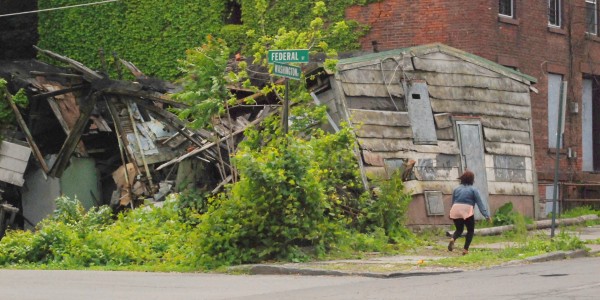
- Despite major improvements in pockets of property around Broadway, stark reminders of the city”™s ongoing struggle to put neglected buildings to use remain. Photo by Reece Alvarez
While unemployment is relatively low at 8.3 percent, economic hardship plays a major role in the city”™s troubles ”” the median income for a household in the city was $30,332, according to 2010 U.S. Census data. The national median income for a family was $32,519.
A quarter of the city”™s population has income below the poverty line, including 35.3 percent of those under age 18. In addition, more than 2,100 of the city”™s housing units are considered vacant ”” making up approximately 19 percent of the total number of housing units, according to the Newburgh Community Land Bank, a not-for-profit land-use organization created by New York state.
But beyond the demoralizing statistics and dilapidated neighborhoods, the city has been undergoing a strategic revitalization of its downtown that is steadily gaining momentum ”” with significant steps toward progress planned for this summer.
The Community Land Bank along with Safe Harbors of the Hudson and Habitat for Humanity of Greater Newburgh are working independently and in coordination with the city government and developers to breathe new life into the city”™s downtown.
“Ultimately, beauty attracts prosperity,” City Manager Michael Ciaravino said.

- Parmenter Street is an example of what large-scale rehabilitation can look like. Rather than address one building on one block, Newburgh”™s chapter of Habitat for Humanity launched a multiyear project to restore the neighborhood through the development of more than 20 homes, with the last of the bunch completed in 2014. Photo courtesy Habitat for Humanity
The idea that small improvements in the city”™s center can help link revitalization projects in the surrounding blocks off Broadway, the city”™s main artery, is the driving theme behind a project to be launched this summer known as the Central Hudson Broadway Corridor Demonstration Project.
“It is a demonstration of what is possible,” Ciaravino said.
Funded by a $250,000 grant from Central Hudson Gas & Electric, the city government and the land bank have come together with the help of Pace University Land Use Law Center to develop greenspace and streetscape enhancements to give the three-block corridor along Broadway between Johnston and Liberty streets the look and feel of a walkable and vibrant city.
“In this particular area, as well as all along Broadway, crossing is difficult. Streets are hard to navigate, not attractive, not easy for pedestrian or bike travel,” said Madeline Fletcher, executive director of the Community Land Bank. “We also feel like this intersection of Liberty Street and Broadway is the city center and we want to treat it as that ”” we want people to know it and associate with it.”

- The intersection of Broadway and Liberty Street has been ground zero for revitalization projects that have been completed and in development since the early 2000s. Photo by Reece Alvarez
Broadway, an especially wide four-lane street, is bisected by a number of streets that make it difficult for motorists and pedestrians alike. Throughout the day pedestrians jaywalk across the busy street and blind corners are especially dangerous for jaywalkers as motorists turn onto Broadway.
Through crosswalk safety measures such as curb extensions, sidewalk improvements and the development of greenspaces, the project aims to plant the seeds of revitalization and reinvigorate the downtown as both a destination for residents and visitors.
The exact plans for the enhancements are in the design phase, but City Planner Alexandra Church said she expects the greenspace improvements on two long empty building lots to begin in June while street enhancements could begin as early as August.
The final design is scheduled to be presented to the public at the Newburgh Illuminated Festival on June 20, which is in itself a sign of the revitalization.
Now in its third year, the festival is a focused effort to draw the community into the city center and display the best of the city”™s food, artists and entertainment.
Examples of the ongoing restoration can be found in pockets all around the city”™s main corridor.
South of Broadway on Liberty Street, just several blocks from the scene of two shootings in May, Philippe Pierre is gutting the ground floor of his recently purchased building at 115 Liberty St. in preparation for a wine shop.

- Philippe Pierre and his development company Liberty Street Partners have invested in several properties close to the Newburgh”™s downtown area, including the 96 Broadway property and 115 Liberty St., pictured, where he intends to open a wine shop and residential space. Photo by Reece Alvarez
“Things may be happening around Liberty Street,” he said. “It is hard to tell.”
Pierre and fellow developers at Liberty Street Partners have made several investments in Newburgh real estate in the past two years including the “iconic” yet badly neglected historic building at 96 Broadway ”” what Pierre refers to as his company”™s “signature” project.
“It has a long troubled history over the years, that”™s why it looks the way it does. It is a testament to how things can fail, how being uncompromising doesn”™t lead to any winners,” he said. “I think people just drive past it and it seems normal to them and I don”™t think they want it to be normal.”
Although the circumstances behind the building”™s current state occurred well before his time, Ciaravino, who just marked his first year as city manager, acknowledged that in the past there have been projects intended for the 96 Broadway property that have been subject to “bureaucratic torture chambers” requiring numerous visits to multiple governing boards. Bureaucracy, coupled with developers”™ plans that did not meet the needs of the community, led the building to fall into neglect, he said.
Yet in a sign of progress, he said the city has worked “feverishly” to develop zoning code reforms to significantly ease and speed up the process for developers.

- One of the most visible dilapidated properties in downtown Newburgh, 96 Broadway is the focus of rehabilitation efforts by developers as well as the Newburgh Community Land Bank. Photo by Reece Alvarez
“Practices that have us going from one of the most bureaucratic and time-delayed bureaucracies to one of the most responsive and real-time municipalities,” he said.
Pierre, who agrees that there have been changes in city hall that have made investing in developing Newburgh easier, is just the latest developer to be part of a wave of redevelopment off Broadway.
Just two blocks from Pierre”™s soon-to-be wine store, Habitat for Humanity completed a long-term project last year replacing blighted and abandoned structures that had been boarded up for more than 20 years with 22 energy-efficient homes and a pocket park on East Parmenter Street.
“I am certainly optimistic, I am hopeful,” Pierre said. “It is a challenge, but it is work that has to be put in to the community because if you are just waiting for someone else to do it you can wait forever. I think I am a little early with this wine shop. As I sit here I don”™t see a lot of people with $13 in their pocket to spend on a nice bottle of wine, but they are there and they will come.”





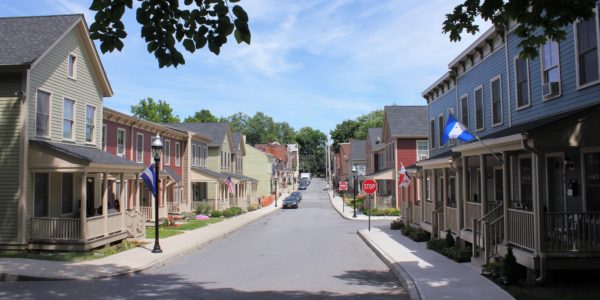
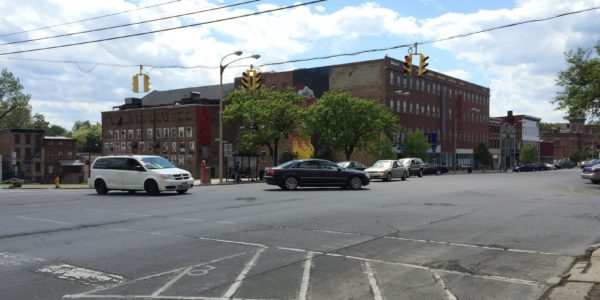
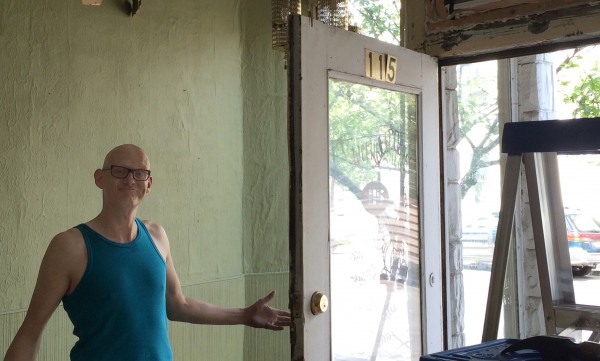
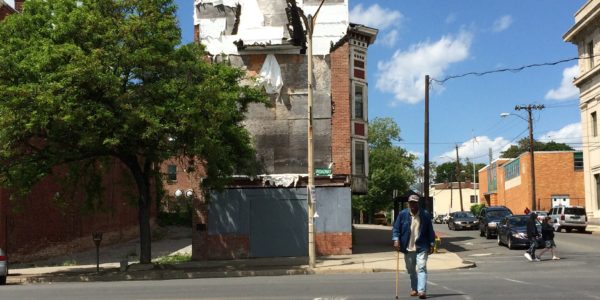
















WHY do so-called “NEWS” articles keep appearing referencing the same old previous news article from 4 years ago? Actually I believe that article is even older but I don’t have time to look it up now. This is a STRATEGY to continue to get FUNDS for an area that is overflowing with non profits, grants, ultra-liberal bleeding heart violin groups and no BANKS or normal financing of developments UNLESS of course the project gets numerous grants, free taxes, and is paid for 100% by the public. THAT is what is ailing Newburgh. TOO much easy money for the scammers who flock there like bees to honey. I don’t know who paid Reece Alvarez to write this article but I will say this…your article needs a good editor to take out the trash you keep recycling. The way they make it sound is like you have to step over dead bodies lying all over the street. That is a SCAM to get you the public to support even more “funding” for the big black insatiable hole of City of Newburgh finances.